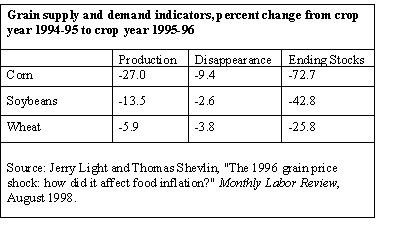An official website of the United States government
 United States Department of Labor
United States Department of Labor
In 1996, the producer price index for corn rose 45.4 percent, soybeans were up 25.1 percent, and wheat prices increased by 15.2 percent. Thus, 1996 met the rule-of-thumb definition of a grain price shock—a 20 percent or greater increase in the price of at least two of these three key feed grains. Drought in the Midwest and West, pessimistic crop forecasts, and robust foreign demand affected the magnitude of the shock.

[Table data—TXT]
Corn production was perhaps most affected by drought. While 1994-95 had seen a record high 10.1 billion bushels of corn produced, the crop fell by more than a quarter to 7.4 billion bushels in 1995-96. Corn "disappearance"—a term for the total demand or use of a commodity (including exports)—also fell, but by not nearly as much. As a result, stocks of corn were reduced by nearly 75 percent, speculation increased, and prices rose sharply.
A similar, but less dramatic, scenario unfolded for soybeans. Production fell 13.5 percent, the rate of disappearance edged down only slightly, and stocks were reduced by nearly half. Prices rose as the soybean markets reacted to these developments.
The story for wheat was somewhat different. The winter wheat crop emerged poorly in the fall of 1995, and scant snow cover exposed the emerging wheat to the unusually cold winter of 1995-96. "Winterkill" was presumed to be extensive and official projections saw the crop to be too severely damaged to make harvesting cost effective. However, the actual drop in production was only 6 percent, by far the smallest among the three key grains, and the reduction of stocks, while significant, was also smaller than for the other feeds. As a result, the price increases for wheat were somewhat more restrained, despite the sensitivity of the commodity markets to the anticipation of a shortage.
Prices at the crude commodity stage of production are measured by the Producer Price Index program. More information about the 1996 grain price shock may be found in "The 1996 grain price shock: how did it affect food inflation?", Monthly Labor Review, August 1998. For a historical look at grain price shocks and their impact on consumer food prices, see "Impact of grain price shocks may be lessening," The Editor's Desk.
Bureau of Labor Statistics, U.S. Department of Labor, The Economics Daily, Three factors led to 1996 grain price shock at https://www.bls.gov/opub/ted/1998/nov/wk1/art01.htm (visited December 05, 2025).

